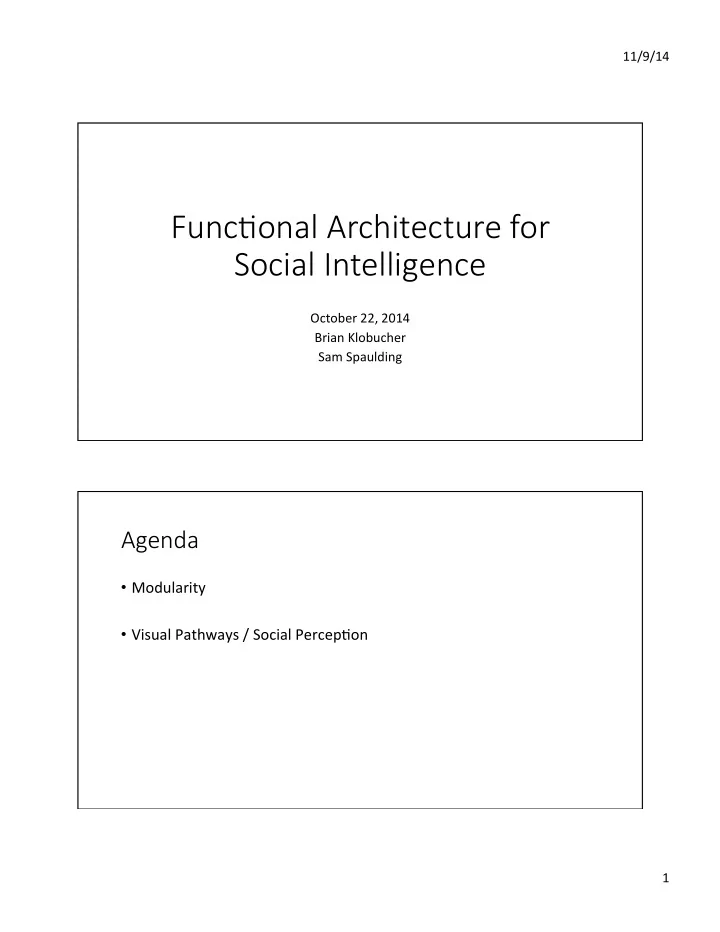

11/9/14 ¡ Func%onal ¡Architecture ¡for ¡ Social ¡Intelligence ¡ October ¡22, ¡2014 ¡ Brian ¡Klobucher ¡ Sam ¡Spaulding ¡ ¡ Agenda • Modularity ¡ • Visual ¡Pathways ¡/ ¡Social ¡PercepCon ¡ 1 ¡
11/9/14 ¡ Modularity Central ¡Ques%on ¡of ¡Modularity • Is ¡the ¡mind ¡a ¡single, ¡general ¡purpose ¡machine ¡or ¡mulCple ¡specialized ¡ systems? ¡ 2 ¡
11/9/14 ¡ History ¡of ¡Modularity • IniCal ¡definiCon ¡(Fodor, ¡1983) ¡ • Narrow ¡and ¡well ¡specified ¡ • Checklist ¡of ¡9 ¡features ¡ + Concrete ¡framework ¡ • Domain ¡specificity ¡ + Established ¡a ¡conceptual ¡vocabulary ¡ • EncapsulaCon ¡ – Too ¡narrow ¡ • AutomaCcity ¡ – Several ¡properCes ¡have ¡since ¡been ¡ • Inaccessibility ¡to ¡consciousness ¡ abandoned ¡ • Speed ¡ • Shallow ¡outputs ¡ • Fixed ¡neural ¡localizaCon ¡ • CharacterisCc ¡breakdown ¡paYerns ¡ Massive ¡(Func%onal) ¡Modularity • Modularity ¡ • A ¡natural ¡property ¡whose ¡nature ¡is ¡to ¡be ¡discovered ¡ • Examine ¡the ¡funcCon ¡first, ¡then ¡look ¡for ¡the ¡underlying ¡structure ¡ • What ¡does ¡the ¡mechanism ¡do? ¡ • What ¡was ¡the ¡mechanism ¡designed ¡to ¡do? ¡ • FuncConal ¡specializaCon ¡ • Specific ¡operaCons ¡on ¡input ¡informaCon ¡ Inputs ¡ Outputs ¡ f(•) ¡ 3 ¡
11/9/14 ¡ Evolu%on ¡and ¡Func%onal ¡Modularity • Natural ¡selecCon ¡ • Shaped ¡the ¡features ¡to ¡saCsfy ¡specific ¡domains ¡ • Specialized ¡informaCon ¡processing ¡ • More ¡effecCve ¡and ¡efficient ¡than ¡generic ¡systems ¡ • Avoids ¡combinatorial ¡explosion ¡(percepCon, ¡linguisCcs, ¡etc.) ¡ • Inputs ¡ • Mechanism ¡consumes ¡relevant ¡informaCon ¡independent ¡of ¡format ¡ • Complementary ¡aspects ¡ • Phobias ¡ • Snakes ¡vs. ¡Electrical ¡outlets ¡ Implica%ons ¡of ¡Func%onal ¡Modularity • Arguments ¡against ¡funcConal ¡modularity ¡ • Implausible/Impossible ¡on ¡a ¡priori ¡grounds ¡ • ViolaCon ¡of ¡1 ¡of ¡Fodor’s ¡features ¡ • Modularity ¡is ¡more ¡ambiguous ¡and ¡interesCng ¡ • Lacking ¡1 ¡or ¡more ¡modularity ¡features ¡does ¡not ¡disprove ¡modularity ¡ • No ¡single ¡list ¡of ¡necessary ¡and ¡sufficient ¡features ¡can ¡capture ¡all ¡possible ¡ funcCon ¡and ¡structure ¡relaConships ¡ 4 ¡
11/9/14 ¡ Cogni%ve ¡Architecture ¡Arguments Against ¡ Counterpoint ¡ Modules ¡cannot ¡integrate ¡informaCon ¡from ¡mulCple ¡ sources ¡because ¡they ¡are ¡informaConally ¡isolated ¡ ¡ • AcCvaCon ¡of ¡mulCple ¡areas ¡of ¡the ¡brain ¡when ¡ • IsolaCng ¡the ¡inputs ¡and ¡contexts ¡to ¡successfully ¡ carrying ¡out ¡a ¡parCcular ¡task ¡ predict ¡which ¡areas ¡of ¡the ¡brain ¡acCvate ¡ • “Central” ¡systems ¡produce ¡context ¡dependent ¡ outputs ¡ ¡ Ex. ¡Hearing ¡words ¡and ¡seeing ¡lips ¡move ¡for ¡a ¡different ¡phrase ¡ Ex. ¡Recognizing ¡someone ¡at ¡the ¡office ¡vs. ¡at ¡the ¡mall ¡ Cogni%ve ¡Architecture ¡Arguments Against ¡ Counterpoint ¡ “Brain ¡plasCcity ¡belies ¡the ¡idea ¡of ¡encapsulated ¡ modularity” ¡(Buller ¡and ¡Hardcastle, ¡2000) ¡ ¡ • Humans ¡possess ¡domain-‑general ¡mechanisms ¡ • Domain-‑general ¡requires ¡hardwired ¡“pipelines” ¡ • CogniCon ¡is ¡sufficiently ¡versaCle ¡ and ¡informaCon ¡rouCng, ¡but ¡not ¡all ¡informaCon ¡is ¡ processed ¡this ¡way ¡ • Devices ¡are ¡sensiCve ¡to ¡its ¡specific ¡inputs ¡and ¡ select ¡its ¡inputs ¡from ¡a ¡common ¡pool ¡ • RouCng ¡is ¡not ¡required ¡ Ex. ¡Eyes ¡and ¡ears ¡are ¡both ¡exposed ¡to ¡light ¡and ¡sound ¡but ¡know ¡which ¡to ¡react ¡to ¡ 5 ¡
11/9/14 ¡ Cogni%ve ¡Architecture ¡Arguments Against ¡ Counterpoint ¡ No ¡characterisCc ¡input-‑output ¡relaCon ¡based ¡on ¡past ¡ ¡ recurrences ¡can ¡solve ¡novel ¡problems ¡ ¡ • Every ¡sCmulus ¡is ¡novel ¡in ¡some ¡dimension ¡ • Relevant ¡criteria ¡are ¡more ¡likely ¡to ¡be ¡spaCal ¡as ¡ opposed ¡to ¡intrinsic ¡ • Conceptual ¡templates ¡can ¡combine ¡various ¡ elements ¡as ¡novel ¡tokens ¡of ¡conceptual ¡types ¡ Ex. ¡Faces ¡are ¡never ¡seen ¡under ¡the ¡exact ¡same ¡condiCons ¡as ¡before ¡ -‑ ¡Can ¡recognize ¡modern ¡devices, ¡even ¡though ¡they ¡are ¡evoluConarily ¡novel ¡ “Modular ¡architectures ¡provide ¡flexibility ¡because ¡they ¡allow ¡components ¡to ¡be ¡assembled ¡and ¡combined ¡in ¡novel ¡ways” ¡ Summary ¡of ¡Modularity • “Principled ¡theory ¡surrounding ¡the ¡funcCon ¡of ¡the ¡mechanism ¡that ¡ predicts ¡the ¡mediaCng ¡effect ¡of ¡context” ¡ • Understand ¡what ¡the ¡“right” ¡inputs, ¡contexts ¡and ¡outputs ¡are ¡ • Discover ¡the ¡underlying ¡structure ¡ • Consistent ¡with ¡evoluCon ¡ 6 ¡
11/9/14 ¡ Ques%ons • What ¡is ¡the ¡coordinaCng ¡mechanism ¡for ¡all ¡of ¡these ¡specialized ¡ systems? ¡ • Engineering ¡analogy ¡ • When ¡you ¡build ¡a ¡system ¡out ¡of ¡modular ¡components, ¡you ¡sacrifice ¡speed, ¡or ¡ size ¡because ¡you ¡have ¡to ¡conform ¡to ¡the ¡constraints ¡of ¡the ¡modules. ¡ ¡Is ¡this ¡ the ¡case ¡with ¡the ¡brain? ¡(“Plug-‑n-‑play”) ¡ Visual ¡Pathways ¡/ ¡Social ¡ Percep%on 7 ¡
Recommend
More recommend